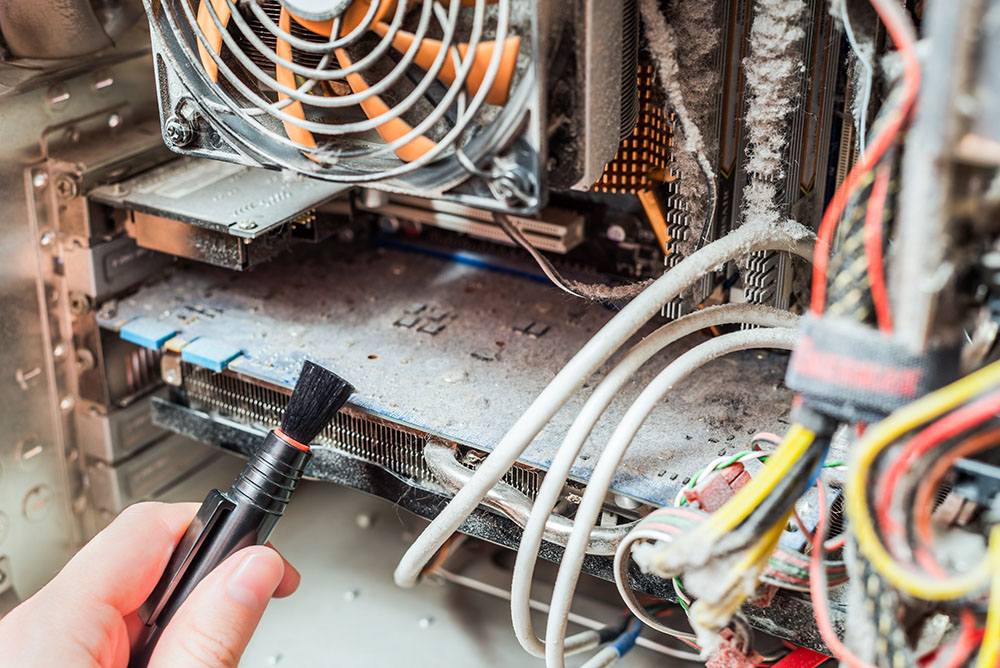Does Mould Grow In Electronics?

CONTENTS
- Understanding the relationship between mould and electronics
- The ideal conditions for mould growth
- The impact of mould on electronic device functionality
- Health implications for users of mould-infected electronics
- Practical tips for preventing mould growth in electronics
- How to safely remove mould from electronics
- Regulatory standards and guidelines in the UK regarding mould in electronics
- Frequently asked questions
- Get in touch
Mould can find its way into the most unexpected places, even the latest technologies like computer hard drives, smartphones, and game consoles. Mould in electronics is more common than you might think, and it can affect device performance, posing health risks.
ICE Cleaning is a professional mould remediation company, working closely with your local council to ensure the highest standards through Awaab's Law are met. We can be on-site the same day in an emergency, providing rapid response cleaning nationwide.
Read on to learn why and how it grows in electronics and practical tips on prevention and safe removal.
Understanding the relationship between mould and electronics
Mould is a common household nuisance that thrives in moist environments like bathrooms or kitchens. However, mould can also invade electronic devices. When exposed to damp conditions or high humidity levels over time, even your devices can be vulnerable to mould.
While not a conventional breeding ground like damp walls or leaky pipes, they provide enough shelter and darkness, allowing mould to spread. Apart from potentially ruining their functionality and reducing their lifespan, using mould-infected electronics might pose serious health risks.
The ideal conditions for mould growth
Mould requires an area that meets its ideal conditions for it to grow. Moisture is key as damp environments let the spores thrive. This could be from high humidity levels or water ingress in electronics.
Besides moisture, mould requires warm temperatures between 24°C - 30°C. That is why overheating electronic devices can become a breeding ground for various types of mould.
Lastly, poor ventilation contributes by trapping moist air around your device. With these three factors combined—moisture, warmth and lack of airflow—there is an ideal setting for mould growth in electronics.
The impact of mould on electronic device functionality
Many believe that mould is limited to damaging organic matter; this is untrue, as the presence of mould can also damage your electronics. The spores of this invasive fungus are small and airborne, making their way into electronic devices easily.
When these spores settle inside an electronic device, they start to grow due to the warmth produced by the device's operation. This growth causes electrical shorts and overheating problems.
Apart from performance difficulties, mould spores presence can lead to early deterioration in components like capacitors or resistors, causing them to malfunction earlier than expected.
Health implications for users of mould-infected electronics
Mould lurking in your electronics is not just bad news for the device but also a potential health hazard to you. The tiny mould spores become airborne, infiltrating our lungs and causing problems like allergies or asthma attacks.
If you regularly use an electronic device with mould, you might notice symptoms such as sneezing, itchy eyes or skin rashes. More severe reactions include difficulty breathing and chest tightness - these should be taken seriously.
Practical tips for preventing mould growth in electronics
To keep your electronics mould-free, you need to follow a consistent cleaning routine and follow these practical tips:
- Ensure good ventilation by opening windows and doors often
- Install extractor fans in bathrooms and kitchens
- Use a dehumidifier in humid parts of your home
- Avoid storing electronics in bathrooms or kitchens
- Clear dust off electronics often
- Clean protective cases and air out the devices
How to safely remove mould from electronics
If you spot mould on your electronic device, start by unplugging the gadget and removing any batteries. Do not try to clean the device yourself, as you may expose yourself to mould spores or aggravate the mould to spread more spores.
You should contact a mould cleaning company to assist you with finding the source of the mould. Although your device may be the root cause, it could have originated from a leak or high humidity.
In regards to your digital device, you should take it to a business that repairs electronics to have it professionally cleaned and repaired. That way, you can isolate a source of the mould whilst your home is cleaned.
Regulatory standards and guidelines in the UK regarding mould in electronics
In the UK, regulations for mould in electronics are vital. The Health and Safety Executive (HSE) sets these standards to ensure user safety and device longevity.
The HSE highlights that employers need to manage risks from exposure to biological agents such as mould. This applies not only to offices but also to homes with remote workers using electronic devices.
The guidelines by BSRIA, a technical services organisation, offer detailed advice on maintaining indoor air quality. They recommend regular cleaning of equipment and the use of anti-microbial treatments when necessary.
A study published by the National Library of Medicine investigated the effects that mould could have on optical instruments. The study concluded that mould can damage electronics through short circuits and corrosion, but this is preventable with regular cleaning.
Frequently asked questions
How do you get mould out of electronics?
To safely remove mould from electronics, first power off and unplug the device. Then, open the device and allow it to air out any spores before you take it to a repair shop.
How do I clean mould off my laptop?
Cleaning your laptop involves powering it down, and unplugging all cables and accessories, then taking it to a repair shop.
Do you have to throw away everything after mould?
Non-porous items can be cleaned and disinfected effectively; however, porous materials like fabrics might require professional cleaning or replacement if heavily infested.
How do you clean mould off circuit boards?
It is best to leave these delicate electronic processors to be handled by professionals at a branded store or repair shop.
Get in touch
Our thorough mould cleaning services are offered nationwide, and our team are on-call 24/7 to help you in emergencies no matter where you are. Our technicians are experts in the field and can eliminate mould from your property, preventing its return in the future.
To learn more about our mould removal services, visit our website today and request a free site survey to speak to one of our advisors. You can reach us at 0208 066 0360 or enquiries@icecleaning.co.uk 24/7, 365 days a year, ensuring you receive the best care and advice daily.

Speak with me today,
I’m here to help
By asking you a few questions either via phone or email I can immediately provide a realistic estimation of the cost.
You’re in good company. We’ve cleaned for the following commercial clients… View all

Why choose us?
- Cater to a wide variety of cleaning situations
- Nationwide coverage, available 24/7
- Cater to commercial and domestic clients
- Free survey provided prior to quotation
- Emergency response team
- Offer a bespoke service designed to suit all your needs
- All technicians hold professional health and safety qualifications, including BICSc, IOSH, Dewpoint Professional & Safe Contractor
We’re fully accredited
We place best practise, professional expertise and health and safety at the core of our business. We’re fully compliant with all legal obligations. You can view a list of our accreditations below, or visit our Health & Safety page for more information.











-RGB-small.1707319151.jpg)




















